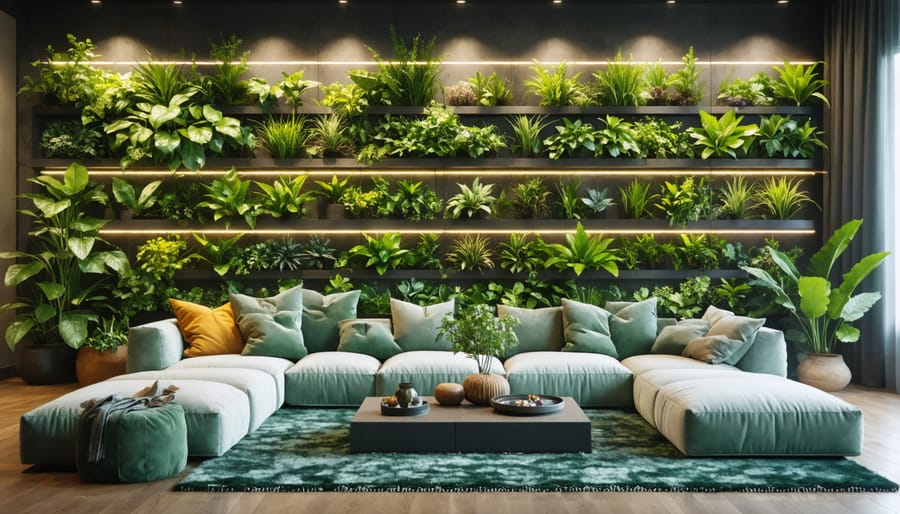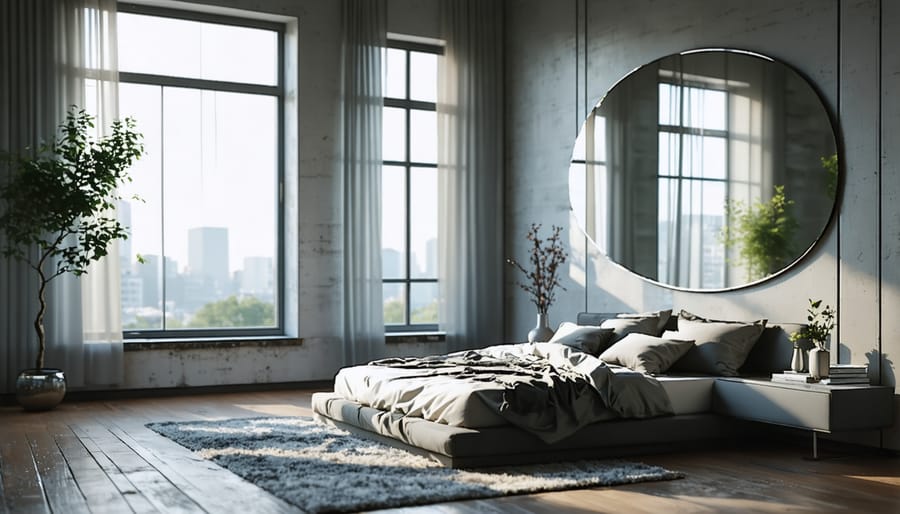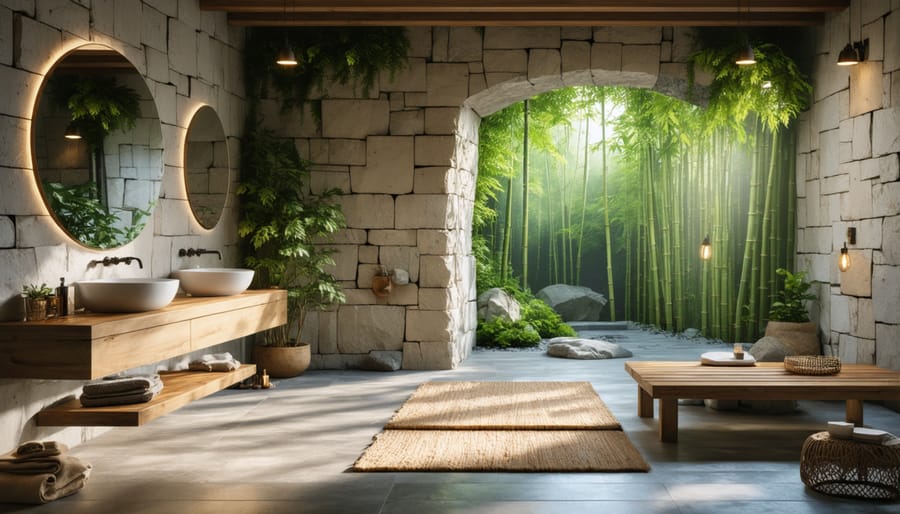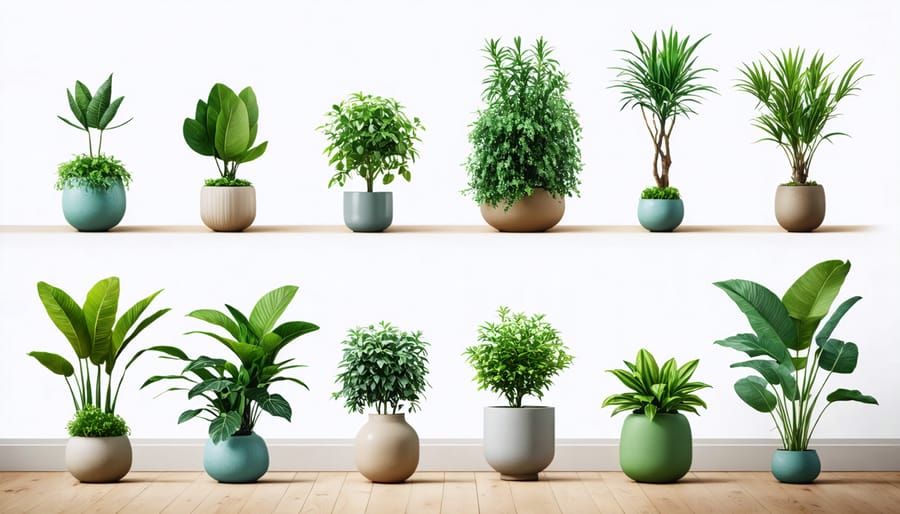Transform your living space into a vibrant, nature-inspired sanctuary by integrating powerful biophilic design elements that reconnect you with the natural world. Install a living wall of low-maintenance plants like pothos and ferns in your most-used room, creating an immediate focal point that purifies air and reduces stress. Position furniture to maximize natural light exposure and create seamless indoor-outdoor transitions using large windows or glass doors framed with natural materials. Layer organic textures through raw wood surfaces, stone accents, and botanical-print textiles to engage multiple senses and create a deep connection with nature. Modern biophilic spaces aren’t just beautiful – they’re scientifically proven to enhance wellbeing, boost creativity, and reduce stress levels by up to 60%. Whether you’re planning a complete renovation or seeking simple weekend updates, incorporating these nature-inspired elements brings the therapeutic benefits of the outdoors into your daily living environment.
Living Walls and Vertical Gardens
Self-Watering Living Wall Systems
Self-watering living wall systems have revolutionized how we incorporate greenery into our indoor spaces, making it easier than ever to maintain thriving vertical gardens. If you’re exploring living wall ideas, these automated systems offer a perfect blend of beauty and practicality.
These innovative systems typically feature a reservoir at the base that feeds water to plants through capillary action or small pumps. The water slowly moves upward through specially designed panels or pockets, ensuring each plant receives consistent moisture. Most systems include built-in sensors that monitor water levels and soil moisture, taking the guesswork out of plant care.
For smaller spaces, modular self-watering panels can be installed individually or grouped together. These are perfect for apartment dwellers or those just starting with vertical gardening. Larger spaces might benefit from comprehensive systems that cover entire walls and include programmable irrigation schedules.
When choosing plants, opt for varieties that thrive in similar moisture conditions. Popular choices include pothos, ferns, peace lilies, and philodendrons. These plants not only look beautiful but also help purify indoor air and create a more relaxing environment.
Remember to position your living wall where it can receive appropriate lighting, and ensure proper drainage is in place. While these systems require some initial setup, they’ll save you countless hours of maintenance in the long run.

Small-Space Vertical Garden Solutions
Even in the smallest spaces, vertical gardens can transform your home into a lush oasis. Start with a simple living wall pocket system near a window, where you can grow compact herbs like mint, basil, and thyme. These not only add greenery but also provide fresh ingredients for your kitchen.
For rental-friendly options, try mounting adjustable tension rods between walls to hang lightweight planters. Alternatively, repurpose a shoe organizer into a vertical garden by filling the pockets with soil and small plants – perfect for those who love creative DIY solutions.
Make use of corner spaces with triangular shelving units designed specifically for plants. Stack air plants and small succulents in geometric wall planters to create an eye-catching living artwork. For those with limited floor space, consider installing a pegboard system where you can adjust plant positions seasonally to optimize light exposure.
Smart tech enthusiasts might enjoy self-watering vertical garden systems with built-in irrigation. These are especially practical for busy professionals who want the benefits of indoor plants without intensive maintenance requirements.
Remember to choose plants based on your available light conditions. Low-light varieties like pothos, snake plants, and peace lilies thrive in most indoor environments and work beautifully in vertical arrangements. Start small with just a few plants and gradually expand your garden as you become more confident in your plant-care abilities.
Natural Light and Views

Window Treatment Strategies
Natural light is a cornerstone of biophilic design, and thoughtful window treatments can help you maximize its benefits while maintaining comfort and privacy. Start by keeping windows clear of heavy, light-blocking curtains and opt instead for sheer, layered solutions that filter sunlight beautifully throughout the day. Consider installing light-filtering roller shades in natural materials like bamboo or linen, which create a soft, organic ambiance while complementing your smart lighting design.
For privacy without sacrificing natural light, try frosted window films that mimic etched glass patterns inspired by nature – think tree branches, leaves, or flowing water designs. These films allow plenty of light while creating an artistic focal point. Another effective strategy is to install top-down, bottom-up cellular shades, which let you adjust natural light levels precisely while maintaining privacy.
Don’t forget about window sills – transform them into mini garden spaces with small potted plants or herbs that thrive in direct sunlight. For a more dramatic effect, hang trailing plants like pothos or string of pearls above windows to create natural curtain-like elements that dance in the breeze when windows are open.
Pro tip: Position mirrors strategically opposite windows to bounce natural light deeper into your space, creating a brighter, more connected feeling throughout the room while amplifying views of outdoor greenery.
Mirror Placement for Light Enhancement
Strategic mirror placement is one of the most effective ways to amplify natural light and create a stronger connection with the outdoors in your biophilic design. When positioned correctly, mirrors can double the visual impact of your greenery while bringing more sunlight into darker corners of your space.
For maximum impact, place large mirrors opposite windows to reflect both natural light and outdoor views. This creates the illusion of an additional window and helps distribute sunlight deeper into your room. Consider installing a floor-to-ceiling mirror to dramatically increase the perceived size of your space while multiplying the visual presence of indoor plants.
In areas with limited natural light, try placing mirrors adjacent to windows at a 45-degree angle. This technique helps bounce light into shadowy areas while creating interesting visual perspectives of your outdoor environment. For a more subtle approach, incorporate smaller decorative mirrors in clusters on walls facing natural light sources.
Remember to consider the reflection’s content – aim to capture views of trees, gardens, or sky rather than less appealing elements like blank walls or cluttered spaces. In rooms with house plants, position mirrors to reflect your green companions, creating the impression of a more lush, abundant space.
Avoid placing mirrors in direct sunlight to prevent harsh glare, and clean them regularly to maintain their light-enhancing properties. With thoughtful placement, mirrors can become a powerful tool in your biophilic design strategy, bringing more of nature’s beauty and light into your living space.
Natural Materials and Textures
Sustainable Wood Applications
Wood brings warmth and authenticity to any space, making it a cornerstone of natural elements in home design. Here are some creative ways to incorporate sustainable wood elements into your modern interior:
Consider reclaimed wood accent walls, which tell a story while reducing environmental impact. These can be installed in a herringbone pattern or as irregular planks for visual interest. For a subtle touch, floating wooden shelves made from FSC-certified timber offer both functionality and natural beauty.
Kitchen spaces benefit wonderfully from wooden elements – think bamboo countertops or sustainable oak cabinet fronts. These choices bring nature’s texture while being highly durable. In living areas, a statement piece like a live-edge coffee table becomes an instant conversation starter.
Don’t overlook smaller details: wooden picture frames, decorative bowls, or even wooden light fixtures can add organic warmth to any room. For a modern twist, mix wood with other materials like glass or metal to create striking contrasts.
Remember to choose woods with environmental certifications and consider local sources to reduce transportation impact. Natural wood treatments like linseed oil or beeswax help maintain the material’s beauty while keeping toxic finishes out of your space. These thoughtful choices ensure your biophilic design elements are truly sustainable and health-conscious.
Stone and Earth-Based Materials
Natural stone and earth-based materials bring the raw beauty of the outdoors into your living spaces, creating a profound connection with nature. From sleek granite countertops to rustic slate flooring, these elements add texture, durability, and timeless appeal to any room.
Consider incorporating exposed brick walls, which tell a story through their weathered surfaces and natural imperfections. For a more polished look, marble accents in bathrooms or kitchens create an elegant touch while maintaining that crucial link to nature. River rocks can be used in shower floors or as decorative elements, providing a gentle foot massage while evoking memories of streamside walks.
Earth-toned ceramic tiles and terracotta elements bring warmth and groundedness to your space. Try arranging natural stone pebbles in clear glass containers as centerpieces, or use large stone slabs as striking accent pieces. For a budget-friendly approach, consider sandstone or limestone wall cladding in small sections rather than entire walls.
Don’t forget about maintenance – most stone surfaces need periodic sealing to maintain their beauty. When selecting materials, opt for locally sourced options when possible to reduce environmental impact and create an authentic connection to your region’s natural landscape. Even small touches, like stone cabinet pulls or earthenware pottery, can make a significant impact in bringing natural elements into your daily environment.

Water Features and Sound Elements
Indoor Fountain Ideas
Indoor fountains offer a delightful way to bring the soothing sounds and visual appeal of flowing water into your living space. For larger areas, consider a wall-mounted cascade fountain that creates a dramatic focal point while humidifying the air. These can be customized with natural stone or copper elements to match your décor.
For tabletop options, compact bamboo fountains work beautifully on side tables or desks, offering a zen-like atmosphere perfect for work or relaxation. Ceramic bowl fountains with smooth river rocks provide a more contemporary look and are ideal for coffee tables or entry consoles.
If you’re feeling creative, try crafting a terrarium fountain using a glass container, small pump, and aquatic plants. These mini ecosystems double as conversation pieces and natural humidifiers. For minimal maintenance, opt for self-contained units with built-in water reservoirs that only need weekly top-offs.
When selecting your fountain, consider the room’s size and ambient noise level. A gentle trickle works well in quiet spaces like bedrooms, while living areas can accommodate more dramatic water features. Remember to place your fountain near an electrical outlet and on a water-resistant surface to protect your furniture.
Natural Sound Integration
The gentle trickle of water or rustling of leaves can transform your living space into a calming sanctuary. Installing a small indoor water feature, such as a tabletop fountain or wall-mounted waterfall, creates a soothing ambiance while naturally humidifying the air. These features work particularly well in home offices or meditation spaces.
Consider placing wind chimes near windows that catch natural breezes, selecting those made from natural materials like bamboo or ceramic for authentic sounds. Smart speakers can be strategically positioned to play nature soundscapes, from gentle rain to forest atmospheres, creating an immersive experience without permanent installations.
For a more subtle approach, position plants near ventilation sources or windows – the natural movement of leaves creates gentle rustling sounds. Hanging bamboo curtains or reed screens can produce delicate natural sounds when air flows through them. Even something as simple as a bowl of polished river stones near a fan can create gentle, nature-inspired acoustics.
For maximum impact, layer different sound elements throughout your space. Combine a small water feature in your living room with strategic plant placement near windows, creating a multi-dimensional soundscape that changes naturally throughout the day.
Plant Selection and Placement
Low-Maintenance Indoor Plants
Not everyone has a green thumb or endless hours to dedicate to plant care, but that shouldn’t stop you from embracing biophilic design. These low-maintenance indoor plants are perfect for busy homeowners who want to add natural elements to their space without the stress of complicated care routines.
The ZZ Plant (Zamioculcas zamiifolia) tops our list as one of the most forgiving houseplants. It thrives in low-light conditions and can go weeks without watering, making it perfect for office spaces or darker corners. Snake Plants (Sansevieria) are equally hardy and actually prefer to be left alone, plus they’re excellent air purifiers.
Pothos plants are another fantastic option, with their trailing vines adding visual interest to shelves and bookcases. They adapt well to various light conditions and can bounce back easily if you occasionally forget to water them. For those seeking something more structural, the Cast Iron Plant (Aspidistra elatior) lives up to its name with incredible durability.
Chinese Evergreen (Aglaonema) offers beautiful variegated leaves and can handle everything from low light to irregular watering schedules. Spider Plants are another foolproof choice, producing adorable “babies” that can be propagated to expand your indoor garden.
Pro tip: Group these plants together to create a low-maintenance green corner. Most of these varieties prefer to dry out between waterings, so you’re less likely to overwater them – the most common cause of houseplant death. Remember, it’s better to underwater than overwater these hardy specimens.

Creative Plant Display Ideas
Elevate your biophilic design with innovative ways to style indoor plants that go beyond traditional pots and planters. Create a striking vertical garden using modular wall-mounted planters, perfect for maximizing space in smaller rooms while making a bold statement. Consider hanging macramé plant holders at varying heights to add visual interest and dimension to your space.
Transform unused corners into lush plant havens by installing floating shelves in a zigzag pattern, allowing trailing plants to cascade naturally. For a modern twist, incorporate geometric terrariums filled with air plants and succulents, which can be grouped together as living art installations or scattered throughout your space as accent pieces.
Make use of unexpected spaces by mounting air plants on driftwood or creating mini garden scenes under glass cloches. Window seats can become natural plant displays by adding custom-built planter boxes that catch optimal sunlight. For a unique room divider, try suspended rope systems with attached planters, creating a living screen that adds both privacy and natural beauty.
Don’t overlook furniture integration – hollow coffee tables with built-in planters or bookshelf arrangements that alternate between books and plants create organic focal points. For bathroom spaces, install shower plants that thrive in humidity, hanging from ceiling hooks or mounted on shower walls. Remember to group plants with similar care requirements together for easier maintenance and a more cohesive look.
These creative displays not only showcase your greenery but also contribute to better air quality and a more nature-connected living environment.
Bringing nature into your living space isn’t just about creating a beautiful environment – it’s about fostering a deeper connection with the natural world and enhancing your overall wellbeing. As we’ve explored throughout this guide, biophilic design offers countless possibilities for transforming your home into a nurturing sanctuary that celebrates nature’s beauty and healing properties.
Whether you start small with potted plants and natural textiles or dive into larger projects like living walls and water features, remember that every step toward biophilic design is meaningful. The key is to choose elements that resonate with your lifestyle, space constraints, and maintenance capabilities while staying true to nature’s organic patterns and processes.
Consider beginning with simple changes: introduce a few low-maintenance plants, swap out synthetic materials for natural alternatives, or maximize your natural light exposure. As you become more comfortable with these elements, you can gradually incorporate more complex features that align with your vision and budget.
Remember that biophilic design is highly personal – what works in one space may not work in another. Don’t be afraid to experiment and adjust your approach until you find the perfect balance for your home. The beauty of this design philosophy lies in its flexibility and adaptability to different spaces and preferences.
Most importantly, observe how these natural elements affect your mood, productivity, and overall sense of wellbeing. Many people report feeling more relaxed, focused, and connected to their environment after implementing biophilic design principles. By thoughtfully incorporating nature into your living space, you’re not just following a design trend – you’re investing in your physical and mental health while creating a more sustainable, harmonious home environment.
